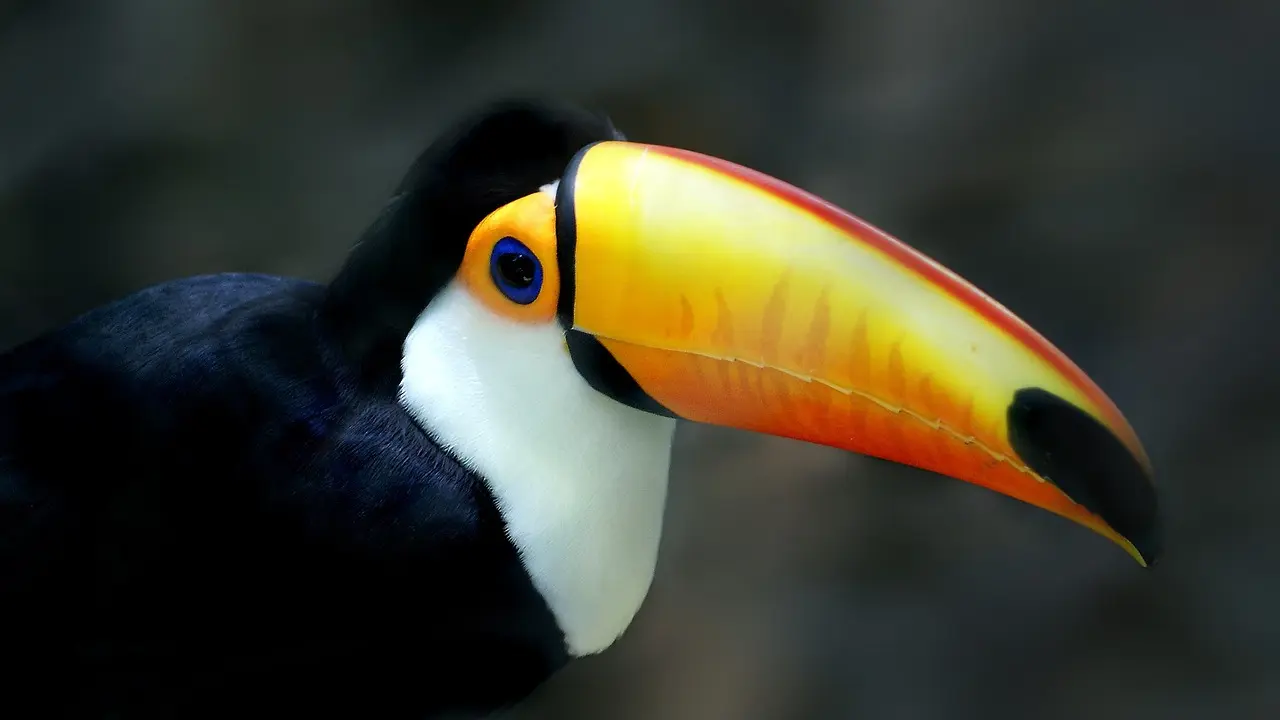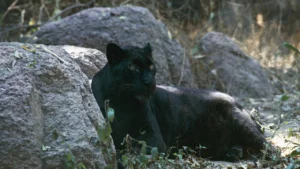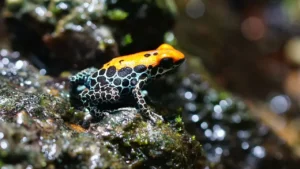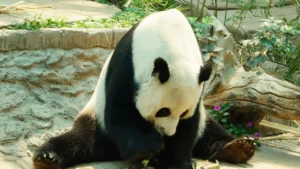Table of Contents
In the dense rainforests of Central and South America, a vibrant and charismatic bird captivates the hearts and minds of all who encounter it. With its strikingly colorful plumage, oversized bill, and playful demeanor, the toucan bird stands out as one of the most iconic and beloved creatures of the tropical wilderness. In this comprehensive guide, we delve deep into the captivating world of the toucan bird, exploring its unique characteristics, behavior, habitat, conservation status, and cultural significance.
Introduction To Toucans Bird
The toucan bird belongs to the family Ramphastidae, comprising approximately 40 species known for their distinctive large, colorful bills. These magnificent birds are native to the rainforests of Central and South America, where they play a vital role in maintaining ecological balance as seed dispersers and predators of insects and small reptiles.
Toucans are celebrated for their stunning plumage, which features a kaleidoscope of colors ranging from vibrant reds, yellows, blues, and greens. Their iconic bills, while often portrayed as heavy and cumbersome, are surprisingly lightweight due to their hollow structure composed of keratin—the same material found in human hair and nails.
Despite their large bills, toucans are agile flyers, capable of navigating dense forest canopies with precision and grace. Their distinctive calls, characterized by a series of croaks, clucks, and yelps, echo through the jungle, serving as a means of communication and territorial defense.
Anatomy And Adaptations
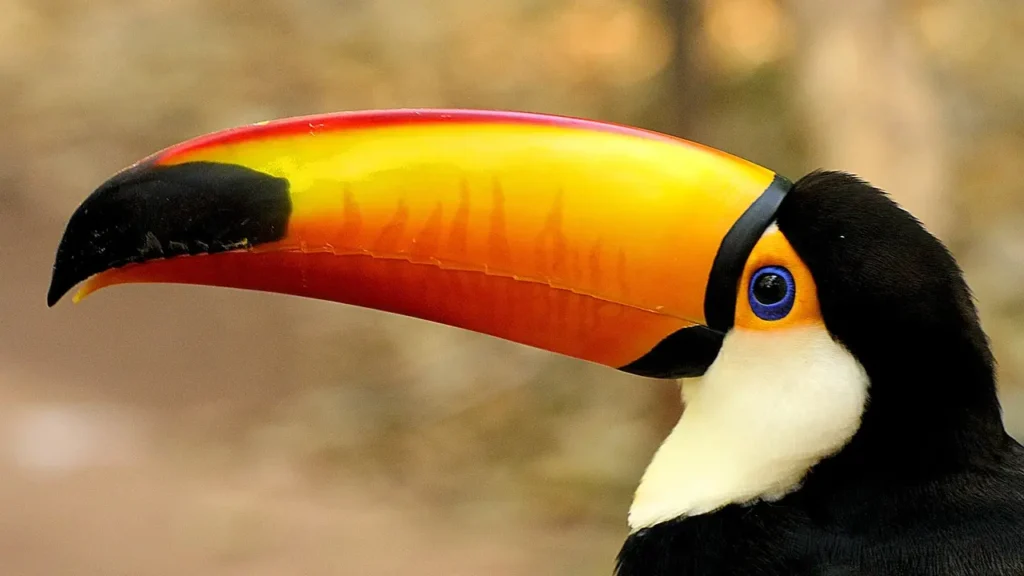
One of the most striking features of the toucan bird is undoubtedly its oversized bill, which can measure up to half the length of its body. Contrary to popular belief, the toucan’s bill is not used for hunting or eating large prey but rather serves multiple purposes, including thermoregulation, social signaling, and attracting potential mates.
The bill’s vibrant colors and intricate patterns play a crucial role in species recognition and mate selection, with each toucan species possessing a unique bill morphology. Additionally, the bill’s large surface area helps regulate the bird’s body temperature by dissipating excess heat—a vital adaptation for life in the humid tropics.
Toucans also possess specialized feet with zygodactylous toes, meaning two toes point forward, and two toes point backward. This arrangement provides them with a secure grip on branches and allows for efficient hopping and climbing within the dense forest canopy.
Another fascinating adaptation of toucans is their diet, which primarily consists of fruits, but they also consume a variety of insects, lizards, and small birds.
Behavior and Social Structure: Insights into Toucan Ecology
Toucans are highly social birds that typically form small flocks consisting of mated pairs and their offspring. Within these social groups, individuals engage in a variety of behaviors, including mutual preening, allopreening (grooming each other), and cooperative foraging.
One of the most endearing behaviors of toucans is their playful nature, often engaging in acrobatic displays, bill-tapping rituals, and aerial pursuits within the forest canopy. These playful interactions serve to strengthen social bonds, establish dominance hierarchies, and maintain group cohesion.
During the breeding season, toucans construct their nests in tree hollows or abandoned woodpecker nests, where females lay clutches of two to four eggs. Both parents take turns incubating the eggs and caring for the chicks, regurgitating food to feed their offspring until they are old enough to fledge.
Toucans are known for their vocalizations, which play a vital role in communication within the flock. Their calls vary in pitch, duration, and intensity, serving as territorial markers, mating displays, and alarm signals to alert others of potential threats.
Habitat and Distribution
Toucans are primarily found in the tropical rainforests of Central and South America, where they inhabit a diverse range of ecosystems, including lowland jungles, montane forests, and cloud forests. They are particularly abundant in countries such as Brazil, Costa Rica, Colombia, and Ecuador, where dense vegetation and abundant fruiting trees provide ample food and shelter.
Within their preferred habitats, toucans occupy the forest canopy, where they forage for fruits, insects, and other small prey items. Their agile flight and adept maneuverability allow them to navigate the dense foliage with ease, accessing otherwise inaccessible resources.
Toucans are considered indicator species of forest health, as their presence and abundance serve as indicators of ecosystem integrity and biodiversity. Unfortunately, habitat loss, deforestation, and illegal wildlife trade pose significant threats to toucan populations, leading to declines in numbers and range contraction in certain areas.
Safeguarding the Future of Toucans
Several species of toucans are listed as “Least Concern” by the International Union for Conservation of Nature (IUCN), indicating stable populations and minimal threats. However, a number of species are classified as “Near Threatened” or “Vulnerable” due to habitat loss, deforestation, and human activities.
One of the primary threats facing toucans is habitat destruction, driven by agricultural expansion, logging, and infrastructure development. Deforestation not only reduces the availability of suitable habitat but also fragments populations, leading to isolation and genetic bottlenecks that threaten long-term viability.
Additionally, toucans are often targeted by illegal wildlife traffickers for the exotic pet trade, where they are captured and sold for profit. This unsustainable practice not only depletes wild populations but also disrupts social structures and genetic diversity within remaining populations.
Conservation efforts aimed at protecting toucans and their habitats include the establishment of protected areas, reforestation initiatives, and community-based conservation programs. Education and outreach are also crucial in raising awareness about the importance of preserving toucan habitats and promoting sustainable land use practices.
Cultural Significance: Toucans in Art, Mythology, and Symbolism
Throughout history, toucans have captured the imagination of people around the world, inspiring awe and admiration with their vibrant colors and exotic appearance. In indigenous cultures of the Americas, toucans are often depicted in art, folklore, and mythology as symbols of beauty, abundance, and spiritual significance.
In pre-Columbian civilizations such as the Maya and Aztec, toucans were revered as sacred animals associated with deities of fertility, rain, and the natural world. Their colorful plumage and melodious calls were believed to bring blessings of prosperity and good fortune to those who encountered them.
Toucans also hold a prominent place in contemporary culture, appearing in literature, music, and visual arts as iconic symbols of tropical biodiversity and exotic beauty. From children’s books and animated films to fashion design and advertising, toucans continue to captivate audiences of all ages with their charm and charisma.
Captive Care: Tips for Responsible Toucan Ownership
While toucans are undoubtedly fascinating creatures, they require specialized care and accommodations to thrive in captivity. As highly social and intelligent birds, toucans need ample space to fly, explore, and engage in natural behaviors.
Conclusion
In conclusion, the toucan is not merely a bird of stunning beauty but also a keystone species whose survival is intricately linked to the health and vitality of tropical ecosystems. Through their feeding habits, social behaviors, and ecological contributions, toucans embody the interconnectedness of all living things and remind us of the importance of preserving biodiversity and protecting the natural world.
As stewards of the planet, it is our responsibility to safeguard the legacy of the toucan and ensure that future generations have the opportunity to marvel at the splendor of these iconic birds in their natural habitats. By supporting conservation efforts, advocating for sustainable practices, and fostering a deeper appreciation for the wonders of nature, we can help secure a brighter future for toucans and the myriad other species that share our planet’s rich tapestry of life.

